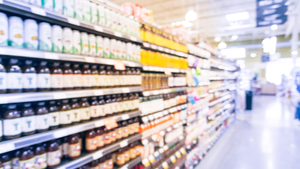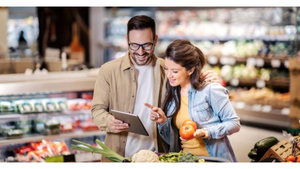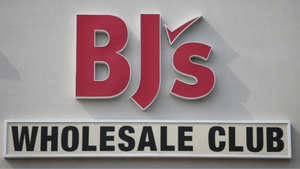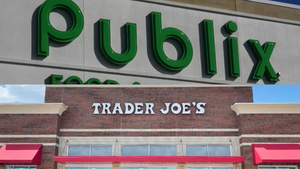Self-Checkout Shrink?Self-Checkout Shrink?
An average person unfamiliar with food retailing might ask the following question about self-checkout systems: Isn't it possible for someone to avoid scanning an item and thereby get away without paying for it? The answer, of course, is that it's possible, but not likely. Self-checkout manufacturers have gone to great lengths to build anti-theft technology into their systems that generally stymies
February 26, 2007
MICHAEL GARRY
An average person unfamiliar with food retailing might ask the following question about self-checkout systems: Isn't it possible for someone to avoid scanning an item and thereby get away without paying for it?
The answer, of course, is that it's possible, but not likely. Self-checkout manufacturers have gone to great lengths to build anti-theft technology into their systems that generally stymies attempts to skip scanning an item or to scan a pack of gum while bagging prime rib. The technology works by weighing each item bagged and comparing its weight to the known weight of the item scanned. If the weights are significantly out of sync, a flag is raised. However, not all systems include these scales, according to Food Marketing Institute, Washington.
Moreover, the self-checkout lanes, like conventional checkout lanes, are typically monitored by cameras that capture and store images of all activity. On top of that, a store associate is dedicated to overseeing the self-checkout area. “Customers aren't going to wait until they are at the self-checkout lanes with cameras pointing at them to rip you off,” said Greg Buzek, president, IHL Consulting Group, Franklin, Tenn. “They'll do it out in the store.”
In fact, Buzek, whose research includes the 2006 North American Self-Checkout Systems Market Study released last year, has found that shrink either remains the same or declines following the deployment of self-checkout. Cashiers at conventional lanes remain a much bigger threat, he noted.
Still, as self-checkout adoption continues to grow in food retailing as well as other retail sectors, the question of its susceptibility to shrink may not be entirely resolved. In the 2006 Retail Shrink Survey, conducted by the National Retail Research Group, Scottsdale, Ariz. (www.retailcontrol.com), 73% of respondents said that total store shrink increased by an average of 3% since the installation of self-checkout, an average of $18,000 annually per store. The survey, released last month, queried 108 supermarket companies representing 26,820 stores, mostly in the U.S.
The survey attributes 52% of self-checkout shrink to customers “sliding” products past the scanner without scanning them, 11% to refunds and voids taken by associates, 10% to associates taking cash from customers and deleting the order, 10% to collusion between associate and customer, 9% to coupon fraud and 8% to allowing associates to access the self-checkout system without uniquely identifying themselves.
At a minimum, the survey suggests that retailers are vulnerable to shrink at the self-checkout if they neglect to follow a set of best practices for managing self-checkout. Many of those practices revolve around selection, training and oversight of employees assigned to the self-checkout area.
FMI also weighed in on this subject for the first time in its Supermarket Security and Loss Prevention 2006 report, published last year. Among surveyed food retailers with self-checkout systems, 63.6% did not note a change in their shrink rates. On the other hand, 22.7% reported an increase in shrink, while 13.6% observed a decline.
The FMI study also reported that 41% of respondents experienced one or more theft cases involving self-checkout in 2005, with a mean of two cases. Three-quarters of all U.S. supermarkets now have at least one self-checkout lane, according to the study.
LEARNING FROM EXPERIENCE
Bi-Lo/Bruno's Supermarkets, Greenville, S.C., which began offering self-checkout in 1999, now has the technology in 140 of its 308 stores, with four to five units per store. Moreover, self-checkout is part of an aggressive remodeling program the retailer has started. The Bi-Lo/Bruno's current self-checkout installations consist of systems from Fujitsu Transaction Solutions and ECRS, but next month the company will select the vendor that will supply its future installations.
Bi-Lo/Bruno's monitors the shrink levels in its self-checkout stores, and overall, “we have not seen an increase in shrink in stores with self-checkout compared with those that don't have it,” said Steve Methvin, director of store systems.
But Methvin acknow-ledged that Bi-Lo/Bruno's has “gone through a lot of growing” in its deployment of self-checkout over the past eight years, resulting in the development of better training and management of employees who oversee the systems. The chain has come to recognize that high shrink levels in a store may be linked to an employee who is wandering away from the self-checkout area or reading a magazine during her shift.
Shrink is not the only consequence of inattentive employees, Methvin noted; self-checkout usage as a whole suffers. While an average of 25% of transactions at the chain's self-checkout stores are handled via the technology (and growing 1% to 2% annually at established stores), some stores report transaction rates of around 10%.
“Low usage generally means a sign of neglect,” he said. “The associate is not there, and then the customer can't get through the self-checkout because it locks up. That customer either doesn't come back or goes to a cashier the next time.”
To ensure that associates are handling the self-checkout area properly, Bi-Lo/Bruno's requires them to go through a certification program. “They go through materials explaining the function of the equipment and then take written tests showing they can recall the important parts,” Methvin said.
Bi-Lo/Bruno's employs POS monitoring software to determine whether associates are engaged in an unusual number of voids or cash-drawer openings at the self-checkout lanes. “We have enough self-checkouts to know what the norms should be,” Methvin said.
Associates selected for the self-checkout area are among the most outgoing in the store. “They need to smile and greet the customers,” he said. “If they don't, they'll get buried there and create a bad impression of the store.”
An engaging associate is a key deterrent to theft at the self-checkout, Methvin said. “If someone feels no one is watching, they may be tempted to steal. But if an associate comes up and says, ‘May I help you?’ — that's all it takes to stop them from stealing.” According to FMI's loss prevention report, fewer than half of retailers with self-checkout train their self-checkout associates to be “greeters.” (See chart, this page.)
Kroger, Cincinnati, also selects its best cashiers for the self-checkout job and, as a reward, allows them flexibility in scheduling their days off, according to Buzek. “They pick their most loyal cashiers, who are most cognizant of the customer and least likely to rip them off,” he said. Kroger did not respond to a request for comment.
Larry Miller, president of National Retail Research Group, believes that self-checkout attendants can serve as “marketers” for the process. Giant Eagle, Pittsburgh, which has IBM self-checkout systems in 131 stores, agrees. “When no customers are present, the ‘pay station attendant’ should stand in front of the register asking the customers if they would like to try self-checkout and help them through the process,” said Russ Ross, chief information officer, Giant Eagle.
REDUCING INTERVENTIONS
At Bi-Lo/Bruno's, associates are required to be on hand at the self-checkout area at all times, both to assist customers and to verify the age of beer, wine and tobacco purchasers. During down periods, the associate is able to put together salad kits for the deli, or assist at the floral department, which is adjacent to the self-checkout area.
About 10% of self-checkout customers at Bi-Lo/Bruno's stores require intervention by the store associate for reasons ranging from age identification to interference with the scanner. IHL Consulting's self-checkout report stated that 33% of self-checkout purchases required intervention from an employee. “Any intervention makes the consumer mad,” said Buzek. “It never happens at the regular POS.”
Buzek said a Home Depot store near him expedites the self-checkout process by not requiring signatures for credit card orders below $25, in contrast with retailers that check on customers' IDs for credit transactions. “Retailers should try to reduce their interventions,” he said. He advocates making the scale technology a little more tolerant of discrepancies to keep the lines moving. “Then you'll see an increase in usage, which will lower checkout costs.”
Retailers can set a more restrictive tolerance for high-ticket items and reduce it for lower-cost items, said Kathy Dawidowicz, product manager, FastLane Self-Checkout Group, NCR, Atlanta. Products like flour require flexibility, owing to the effect of humidity on their weight, she noted.
However, retailers would be ill advised to turn off the weight validation feature altogether, said John Parsons, U-Scan marketing program manager, Fujitsu Transaction Solutions, Frisco, Texas. “If you turn it off temporarily to fix some scanning issue, shrink will go up,” he said.
Parsons suggested installing electronic scales in the produce area so that shoppers can bar-code their produce purchases. That would help expedite the self-checkout process, he said. He also urged retailers to ensure that “99.99% of items scan in a fluid motion.”
Another question is where at the front end the self-checkout lanes should be located. According to the National Retail Research Group study, 61% of respondents put their self-checkout units close to the front doors, while 33% positioned them in the middle of the front end. The report recommends the middle position as the least vulnerable to shrink.
Bi-Lo/Bruno's generally puts its self-checkout systems at either end of the checkout area, depending on the traffic flow of the store. However, Methvin said, the company actually believes the middle is the least confusing spot for customers, assuming that appropriate checkstand fixtures are available.
Older-generation checkstands are too tall, but a more recent, lower-profile system from ECRS works well in the middle, Methvin said. The company has put it there in one store and “we're seeing close to 30% [transaction] usage,” he noted. “We are looking at putting more self-checkout systems in the middle.”
Coupons are yet another potential self-checkout vulnerability. At Bi-Lo/Bruno's, ordinary cents-off coupons can be scanned at the self-checkout and placed in a bin. However, coupons for free items or a percentage off transactions must be approved by the attendant. The system also sets a limit on the number of coupons that can be approved without intervention. “With our POS tracking, we can tell if coupons are being abused,” said Methvin, adding that it's not a significant problem, because not many coupons are processed at the self-checkout area.
Choosing Customer Service
CHARLESTON, S.C. — Piggly Wiggly Carolina Co. here is down to one store with self-checkout lanes. “We're going the opposite way of the industry,” said Rachel Bolt, director of information services.
Piggly Wiggly Carolina, which operates more than 100 stores, was never big on self-checkout. It had been in only four other stores, but was removed after the chain decided that self-checkout conflicted with its focus on customer service. “When you come to a Piggly Wiggly Carolina Store, we want you to interact with associates,” Bolt said. “Self-checkout is viewed as a non-interactive solution that leaves customers to their own defenses.”
In the stores where self-checkout was removed, shoppers were hardly using it; fewer than 10% of transactions went through self-checkout, Bolt said. That's true in the one remaining self-checkout store, but that store has a loyal group of users, so it was left in place. Bolt acknowledged that the chain did not promote the technology.
Piggly Wiggly Carolina was considering a self-checkout solution from NCR that uses a mobile device allowing the attendant to move around the self-checkout area and “engage the customer with customer service,” said Bolt. However, the decision is on hold. “I'd like to see us try it,” she added.
Indeed, Bolt is a proponent of self-checkout technology. “I think in the future it will be like pay-at-the-pump,” she said. “If you don't have it, people won't come.”
— M.G.
About the Author
You May Also Like






